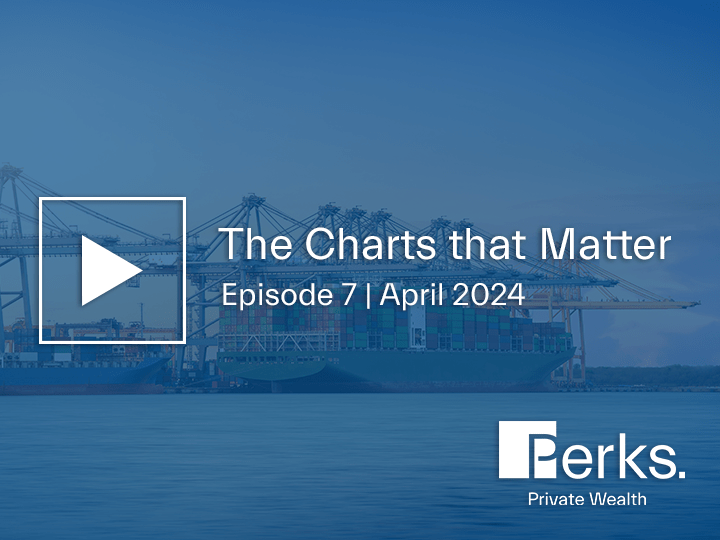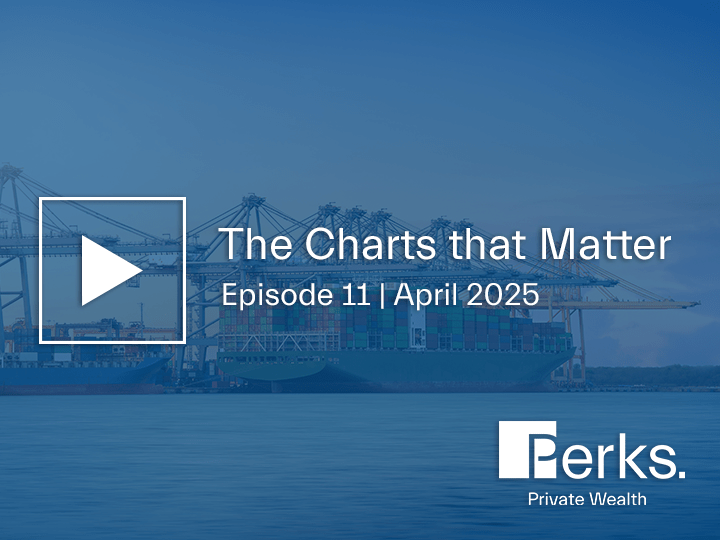Hi, everyone. My name is Simon Hele, Director of Perks Private Wealth, and I’m pleased to welcome you to another edition of the Charts That Matter. As always, I’m joined by Christo Hall, chair of our Investment Committee. Today, I’m going to discuss with him our Investment Committee thoughts and views on markets.
What’s happened? Where are we now? And how we see things going forward? Welcome, Christo.
Thanks, Simon. Good to be here.
Christo, the US economy seems to be extremely, extremely resilient with the US market leading gains into two-thousand-and-twenty-four. Is this market confidence matched in the real economy?
Yeah. That’s a good question, Simon. Look, certainly, the resilience has, surprised many, particularly the US that has been that has been much stronger than expected.
But the other countries, have also, you you know, performed better than expected. Even though we’ve seen this slow down, it hasn’t been as pronounced as, what people were thinking even six months ago.
With the inflation story, that is a big part of the reason why it’s happening. Inflation is coming down at a reasonable click now across the globe, particularly in developed markets. But we think that the next level of data is going to be harder to achieve.
And the two components, of service inflation and we’ll say goods inflation are going to behave differently. So the services part is going to be much more stickier.
If you look at the lead indicators, the lead indicators are certainly bottomed out, particularly, consumer confidence.
But also the PMI, which is a measure of economic activity, that is showing signs of recovery. So the markets have been pricing in this, what we call, Goldilocks scenario, where things are moving into a soft landing.
And that is again evidenced by the fact of the chart showing the property recession, globally is is continuing to fall. So we’re certainly not going into a hard landing scenario economically. The central banks will start easing as we go through, through the year and and into next year, and the property of any, poor recession or hard recession is going to be, unlikely.
So economies are proving to be resilient. Is this reason to be optimistic? The market certainly thinks so.
How have you seen the recent market rally?
Yeah. Well, it’s obviously been very, very strong. So I’m and a lot of that has been centered around, people’s expectations of rate cuts, looking forward, not just in Australia, but around the world. And then if you look at the performance of the market, it’s not just Australia that’s done well. It’s It’s obviously the US particularly, that’s done well, and Japan have been very, very strong.
But the point to make is that if you look at the breadth of the rally in the US market, it’s been very, very narrow. And what that means is when you look at the number of companies that are actually outperforming the market, it’s still very low. It’s around about twenty-five to twenty-seven percent.
So for markets to have real health, they need to have a very broad base of all companies participating in the rally. And clearly, tech has been the big rally here, within the US. And it’s important to note that, the top six tech companies represent around about twenty-seven percent of the market now in the S&P five hundred, so it’s material.
But having said that, I think, you know, we are seeing things, looking better from an earnings perspective, and that’s why the markets are where they are. But it’s important to know that our valuations are looking stretched. If you look at the, the valuations for tech, they’re clearly very, very heightened. They’re very elevated.
And even the broader markets, ex tech, they’re still okay, but they’re starting to look, they’re starting to look elevated relative to history.
So we’re just getting a bit concerned that the market has started to run ahead of itself. It’s run ahead of fundamentals. So we’ve been pricing in rate cuts very, very quickly.
And we’re also been, we have also be pricing in big earnings recovery from these companies very, very quickly.
And just one point to measure, there was a there’s a there’s a chart that will appear on your screen, which is looking at, risk indicators that, one of our suppliers, provides us with, and that is starting to look elevated as well. So we need to be cautious here.
That’s that’s the message given where valuations are.
Things economically, as I said before, are starting to, not appear as drastic as they were, you know, six even six months ago, but a lot of that’s already been priced into the, into the market. So there needs to be a cautious stance taken here.
Thanks, Christo. That’s been incredibly insightful.
We always like to finish these chats by asking you to look into the crystal ball. Can you talk about the markets? What does all this economic data mean? And what’s the outlook for our investments?
Okay. So let’s break it up into, a series of opportunities that we still see within the marketplace. So, we called, bonds as we get very attractive asset class, going back, towards the end of last year or prior to that. And that was when bond yields were at about five percent.
And that was the right call because yields have rallied materially since then.
Where you would sit today, they’re probably, they’re still looking okay from a valuation perspective, but they’re not as attractive as they were.
And a lot of that is based around the inflation, piece, that I mentioned earlier. Same. It’s it’s thing. Now the ability to get inflation down from here going forward is going to be a bit more challenging.
If I look at, emerging markets, again, there’s some real value there, particularly in China. China’s been a a very, very big underperformer, relative to the rest of the world, particularly the US, over the last, over the last couple of years.
But we’re starting to see that gap close just recently. I still think there’s some some very good long term value, in that market, and China’s a big part of the emerging markets basket. But they look, they look they look like an opportunity.
I think we talked about this in the in the last meeting, but Australian small caps are trading at a very, very significant discount to large caps.
And I see that valuation gap as being way too excessive. So as the economy, yes its slowing down, but it’s not going to be, you know, disastrous in Australia.
Those companies are going to begin to recover once we start cutting rates again and the earnings of those companies will begin to recover, and given the valuation gap, I think there’s some, some some real value there.
When I look at list infrastructure, vs. unlisted. Again, there’s some valuation disparity there.
The listed, infrastructure stocks have been, have been marked down quite heavily, but we saw bond yields around this. Whereas the unlisted space is yet to really adjust there. So I see some opportunities that I’ve listed in infrastructure space in the, in the Australian market. You know, good earnings, good inflation hedge. I see some real opportunities there.
And finally, just with the currency. I mean, this is really important.
Then the AU Dollar has been stuck in the sixties for some time now, but it’s been trading below what I see as fair value, which is more at a seventy-two cent level based on where interest rates are and just given where at, you know, trading partners are at with regard to, you know, budget, budget deficits and the like.
So I see the Aussie Dollar beginning to move up as we go through, continue you through to the year two-thousand-and-twenty-four, which will be, you know, certainly a a decision, we need to think about when you’re considering hedging.
They’re my opportunities that I see, going forward.








